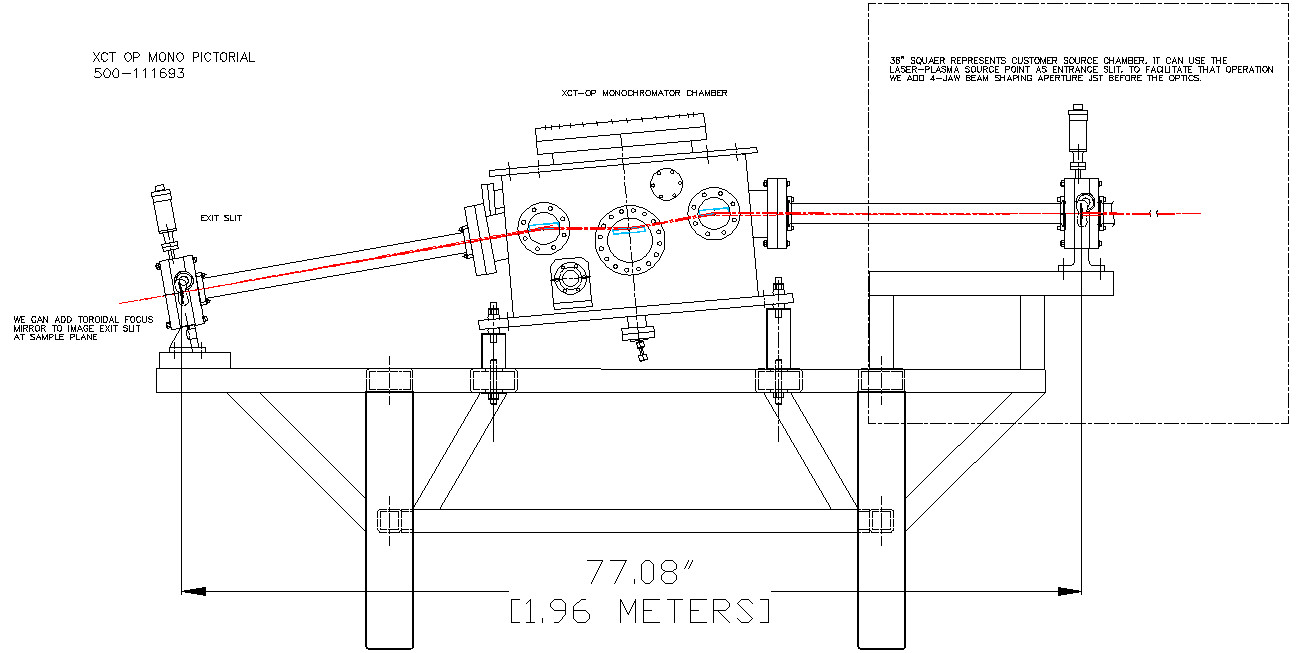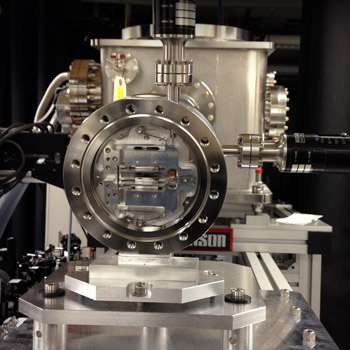| Focal Length | 800 mm (others available when HHG source distances require) |
| Acceptance | 8 mrad |
| Angle of Incidence | 85 degrees (5 degrees grazing incidence) |
| Entrance & Exit Slits> | Continuously variable micrometer actuated width AND height, 0.02 to 6mm |
| Grating Mount | 3-position, adjustable in vacuum |
| Vacuum Compatible | 10-6 torr (optional metal sealed UHV for 10E-10 torr) |
| Gratings | 80 x 30mm substrate |
| Wavelength Range | refer to grating of interest for range |
The XCT may be used for scanning applications with an exit slit or array detectors (eg. CCD or microchannel plate intensifiers.)
Performance with various diffraction gratings:
| Grating groove density (g/mm) (others available) |
1800 |
1200 |
600 |
300 |
| Resolution (nm, FWHM) |
0.06 |
0.08* |
0.16 |
0.32 |
| Grating Range (nm) |
0 to 25 |
0 to 35 |
0 to 75 |
0 to 140 |
| 1st Order Blaze (nm) |
44 |
27 |
84 |
113 |
|
|
19 |
30 |
81 |
|
|
5 |
14 |
|
|
|
3 |
|
|
*measured value with 0.05 mm pinhole at entrance
Outline Drawing

Select Publications
Abstract: Performing time- and angle-resolved photoemission (tr-ARPES) spectroscopy at high momenta necessitates extreme ultraviolet laser pulses, which are typically produced via high harmonic generation (HHG). Despite recent advances, HHG-based setups still require large pulse energies (from hundreds of μJ to mJ) and their energy resolution is limited to tens of meV. Here, we present a novel 11 eV tr-ARPES setup that generates a flux of 5 × 1010 photons/s and achieves an unprecedented energy resolution of 16 meV. It can be operated at high repetition rates (up to 250 kHz) while using input pulse energies down to 3 µJ. We demonstrate these unique capabilities by simultaneously capturing the energy and momentum resolved dynamics in two well-separated momentum space regions of a charge density wave material ErTe3. This novel setup offers the opportunity to study the non-equilibrium band structure of solids with exceptional energy and time resolutions at high repetition rates. [
Link]
Changmin Lee, Timm Rohwer, Edbert J. Sie, Alfred Zong, Edoardo Baldini, Joshua Straquadine, Philip Walmsley, Dillon Gardner, Young S. Lee, Ian R. Fisher, and Nuh Gedik
Abstract: High harmonic generation of ultrafast laser pulses can be used to perform angle-resolved photoemission spectroscopy (ARPES) to map the electronic band structure of materials with
femtosecond time resolution. However, currently it is difficult to reach high momenta with narrow energy resolution. Here, we combine a gas phase extreme ultraviolet (XUV) femtosecond light source, an XUV monochromator, and a time-of-flight electron analyzer to develop XUV-based time-resolved ARPES. Our technique can produce tunable photon energy between 24–33 eV with an unprecedented energy resolution of 30 meV and time resolution of 200 fs. This technique enables time-, energy- and momentum-resolved investigation of the nonequilibrium dynamics of electrons in materials with a full access to their first Brillouin zone. We evaluate the performance of this setup through exemplary measurements on various quantum materials, including WTe2, WSe2, TiSe2, and Bi2Sr2CaCu2O8+δ.
Edbert J. Sie, Timm Rohwer, Changmin Lee, and Nuh Gedik.
Abstract: Presenting means for spectral analysis in the extreme and vacuum ultraviolet, of single or multi-shot plasmas or plasma plumes and their strata, via multi-dimensional view chords. We describe a novel grazing incidence off-plane optical system, related efficiency, and image formation at two dimensional detectors. Method and means of surveying low and high-resolution events and their visualization and recording thereof are illuminated. Our goal is to acquainting investigators with a unique spectrometer (spectrograph) configuration, which with help of state of the art detectors may be useful for plasma diagnostics.
D. Schoeffel, E. Schoeffel, and L. Krupa
Abstract: The design and the characterization of a monochromator for the spectral selection of ultrashort high-order laser harmonics in the extreme ultraviolet are presented. The instrument adopts the double-grating configuration to preserve the length of the optical paths of different diffracted rays, without altering the extremely short duration of the pulse. The gratings are used in the off-plane mount to have high efficiency. The performances of the monochromator have been characterized in terms of spectral response, efficiency, photon flux, imaging properties, and temporal response. In particular, the temporal characterization of the harmonic pulses has been obtained using a cross-correlation method: Pulses as short as 8 fs have been measured at the output of the monochromators, confirming the effectiveness of the time-delay compensated configuration.
Luca Poletto, Paolo Villoresi, Fabio Frassetto, Francesca Calegari, Federico Ferrari, Matteo Lucchini, Giuseppe Sansone, and Mauro Nisoli
Abstract: The conical diffraction mounting in which the direction of incident light belongs to a plane parallel to the direction of the grooves has the unique property of maintaining high diffraction efficiency, even in the extreme-ultraviolet (EUV) region. This property is useful for designing high-throughput time-delay compensated monochromators for the spectral selection of ultrashort EUV pulses as the high-order harmonics generated by the interaction between an ultrashort laser pulse and a gas jet. The time compensation allows one to exploit the femtosecond scale duration of the harmonics both to have high intensity and to reach an unprecedented temporal resolution for pump and probe experiments. Because two gratings have to be used for time compensation, the high diffraction efficiency becomes an essential requirement, which can be fulfilled by the conical diffraction mounting. Measurements recently accomplished at the Bending Magnet for Emission Absorption and Reflectivity (BEAR) beam line (ELETTRA Synchrotron, Trieste, Italy) for three gratings in the 10–90 nm region are reported here that show a peak efficiency of as much as 0.7 in the first order. A model computing the electromagnetic propagation and the grating efficiency, implemented and tested with the experimental data, permits the study and design of rather complex systems operating in the conical mounting. Basic physical principles and mathematical aspects of the model are discussed here.
M. Pascolini, S. Bonora, A. Giglia, N. Mahne, S. Nannarone, and L. Poletto
Abstract: Angle-resolved photoelectron spectroscopy (ARPES) has emerged as a leading technique in identifying equilibrium properties of complex electronic systems as well as their correlated dynamics. By using femtosecond high harmonic generation (HHG) pulses, this technique can be extended to monitor ultrafast changes in the electronic structure in response to an optical excitation. However, the broad bandwidth of the HHG pulses has been a major experimental limitation. In this contribution, we combine the HHG source with an off-axis Czerny-Turner XUV monochromator and a three-dimensional ``ARTOF'' photoelectron detector to achieve an unrivaled overall energy resolution of 50 meV in multiple harmonic energies. Moreover, the use of a stack of different gratings enables us to fine control both the photon energy and time vs. energy resolution to its particular needs. The performance of our setup is demonstrated by studies on the transition metal dichalcogenide IrTe2 which undergoes a first-order structural transition and accompanied reconstruction of the band structure upon cooling without the characteristic opening of an energy gap.
Timm Rohwer, Edbert Sie, Fahad Mahmood,
Nuh Gedik
Chapter 18 opening paragraph: We discuss the use of diffraction gratings to perform the spectral selection of ultrashort
pulses in the extreme-ultraviolet and soft X-ray spectral regions, ranging in the 3-100 nm wavelength range. The main application of such a technique is the spectral selection of highorder laser harmonics and free-electron-laser pulses in the femtosecond time scale. We present the design and realization of both single- and double-grating monochromators using an innovative grating geometry, namely the off-plane mount. The performances of existing instruments are shown. The use of diffraction gratings to change the phase properties of the pulse, e.g. to compress it to shorter temporal duration close to the Fourier limit, is also discussed.
Luca Poletto, Paolo Villoresi and Fabio Frassetto [Source: Advances in Solid-State Lasers: Development and Applications, Book edited by: Mikhail Grishin,
ISBN 978-953-7619-80-0, pp. 630, February 2010, INTECH, Croatia, downloaded from SCIYO.COM]
